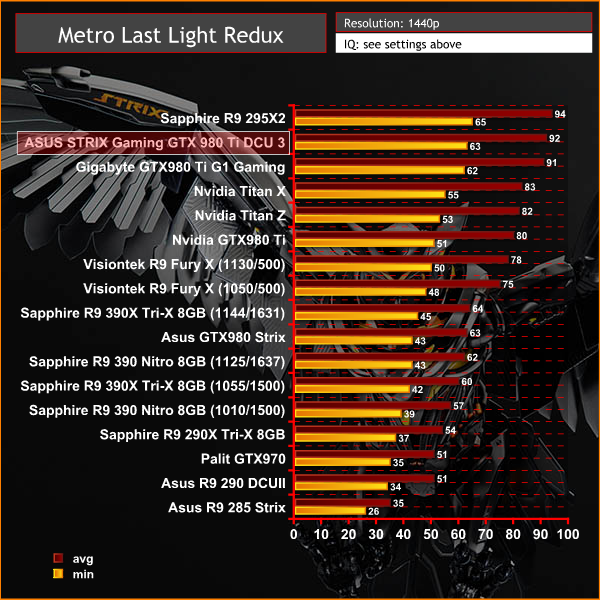
We used the “Performance” preset for this benchmark. The latest version makes extensive use of all the new features in DirectX 11, including tessellation, compute shaders and multi-threading.
#980 ti metro last light benchmark drivers#
(Other cards were tested on older drivers as we didn't have it with us at the time)ģDMark is a computer benchmarking tool created and developed by Futuremark Corporation to determine the performance of a computer’s 3D graphic rendering and CPU workload processing capabilities. With Voxel Global Illumination (VXGI), Nvidia allows a real time global illumination engine which assures realistic reflections.Īdditional Drive: Western Digital Velociraptor, 150GB (secondary)ĭrivers: Nvidia 335.60 (for ZOTAC GTX 980Ti and Nvidia GTX 980Ti) The final result can deliver image quality approaching that of 8xAA at roughly the cost of 4xAA, or 4xAA quality at roughly the cost of 2xAA. It has been introduced to address the issue faced by graphically demanding games, which get a hit in frame rates when you increase the multi-sampling anti-aliasing (MSAA) to highest levels. Multi-frame Anti-aliasing (MFAA) is a feature exclusive to high end Nvidia cards, thanks to a hardware feature: programmable AA sample positions. With the DSR activated, the scenes will be rendered at a higher resolution and then will be scaled down to the native resolution of your display. Apart from this you have support for Nvidia’s features such as Dynamic Super Resolution (DSR), Multi-frame Anti-aliasing (MFAA), Voxel Global Illumination (VXGI), GameStream, G-sync and so on. Also if the Nvidia booth at Computex is any indicator, the GTX 980Ti will also support high end games on VR headsets. For instance, both the cards have 8billion transistors, same core clock speed of 1000MHz and boost clock speed of 1075MHz, 384-bit memory bus width and a maximum TDP of 250W. The rest of the specs on the GTX 980Ti are similar to the TITAN X. The other difference is that the GTX 980Ti comes with 6GB of VRAM which is half of that seen on the TITAN X. So you have 22 SMMs giving you 2816 active CUDA cores. The GM200 on the 980Ti comes with two of the 24 streaming multiprocessors (seen on the TITAN X) disabled. The Nvidia GTX 980Ti is based on the Maxwell architecture and just like the TITAN X, the GTX 980Ti too is based on the GM200 GPU. It requires just one 6-pin and one 8-pin PCIe power connectors. The HDMI 2.0 port also supports 4K at 60Hz.

#980 ti metro last light benchmark series#
As is evident, Nvidia is pushing people to adopt the 4K displays for their systems having the GTX 900 series cards. On the display front, you have 3x DisplayPort 1.2, 1x HDMI 2.0 port and 1x DVI port. In addition to this, Nvidia also allows you to unscrew the top of the back plate just behind the PCIe power ports. The GTX 980Ti adds in a backplate to the card to protect the PCB on the rear side.

This is a departure from the vapour chambers used in the GTX 780Ti and GTX Titan. Under the heat-sink, you have three heat-pipes that transfer heat from the GPU to the heat-sink. Under the gray metallic shroud, you have a black-coloured heat-sink though. On a first glance, the designs look identical – the 65mm radial fan is the same, the flourescent green GeForce logo atop the card is the same, the gray/black sheath is the same. The GTX 980Ti like the GTX 980, GTX 780Ti, GTX TITAN and to an extent the GTX 690 before it, has stuck to the similar gray coloured design with slight variations. Nvidia flagship cards have kind of acquired a uniform design language. For the moment, let us check out the GTX 980Ti.


We will be testing them in the near future. AMD has launched the Radeon R9 Fury X and Radeon R9 Fury, which are its top of the line cards at the moment. It is second only to the TITAN X in terms of feature set. Clearly there was a gap between these two top end cards and as expected, Nvidia’s latest card, the GeForce GTX 980Ti tends to till the gap. Targetted more at the high-end gaming and compute/professional audience, the GTX TITAN X costs double that of GTX 980. Nvidia had launched its GTX 980 last year, which was followed by the GTX TITAN X which has three times the video memory that was seen on the GTX 980.


 0 kommentar(er)
0 kommentar(er)
